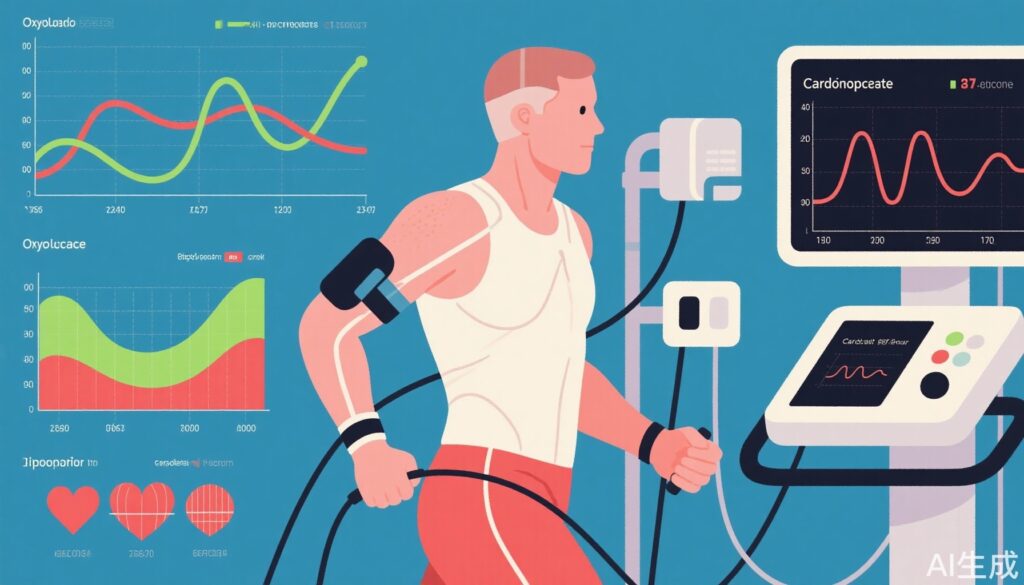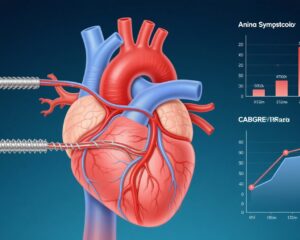Highlight
1. VO2T12.5%, the time for oxygen uptake to decrease by 12.5% post-exercise, is a novel, easily derivable measure reflecting cardiac performance during exercise.
2. Prolonged VO2T12.5% correlates with adverse hemodynamics and predicts higher risks of heart failure hospitalization and mortality in patients with dyspnea on exertion.
3. In obstructive hypertrophic cardiomyopathy (HCM), VO2T12.5% significantly improves with aficamten treatment, aligning with reductions in cardiac biomarkers and outflow tract gradients.
4. VO2T12.5% demonstrates potential as a sensitive, cardiospecific, and prognostically relevant endpoint for cardiopulmonary exercise testing (CPET) in clinical practice and trials.
Study Background and Disease Burden
Post-exercise oxygen uptake recovery (VO2Rec) kinetics provide insights into cardiopulmonary and metabolic integration after exertion. Prolonged VO2Rec is documented in advanced heart failure and reflects impaired cardiac reserve. However, practical, standardized VO2Rec measures that are cardiospecific and prognostically validated in diverse patient populations remain lacking.
Dyspnea on exertion is a common and debilitating symptom in structural and functional cardiac diseases, including heart failure and hypertrophic cardiomyopathy (HCM). Obstructive HCM, characterized by dynamic left ventricular outflow tract (LVOT) obstruction, causes elevated filling pressures, ischemia, and neurohormonal activation, leading to exercise intolerance and morbidity. Novel therapies targeting cardiac-specific mechanisms, such as aficamten — a selective cardiac myosin inhibitor that reduces LVOT obstruction — have shown promise in improving symptoms and cardiac function.
Yet, sensitive, non-invasive biomarkers that can detect cardiac performance changes and predict clinical outcomes remain an unmet need. Measuring VO2Rec kinetics using standardized thresholds like VO2T12.5% offers a potentially simple, physiologically relevant approach to assess exercise recovery that might reflect cardiac pathophysiology and predict prognosis.
Study Design
The investigation included two cohorts:
- MGH-ExS cohort: A referral population (n=814, mean age 58±16 years, 58% women) with dyspnea on exertion, who underwent cardiopulmonary exercise testing (CPET) combined with hemodynamic monitoring to characterize VO2Rec in relation to cardiac performance and clinical outcomes (heart failure hospitalization and death).
- SEQUOIA-HCM trial substudy: A pivotal phase 3 randomized controlled trial involving 263 participants with symptomatic obstructive HCM (mean age 59.1±2.9 years, 41% women), randomized to aficamten versus placebo for 24 weeks. Serial CPET assessments evaluated longitudinal changes in VO2Rec and correlated these to cardiac biomarker and echocardiographic parameters.
VO2Rec was measured consistently using the time for oxygen uptake (VO2) to decline by >0%, 12.5% (VO2T12.5%), 25%, and 50% from peak exercise VO2. The primary outcomes included relationships with invasive hemodynamics, biomarker changes, and clinical event rates.
Key Findings
MGH-ExS Cohort:
Participants with prolonged VO2T12.5% (≥35 seconds) exhibited significantly elevated exercise pulmonary capillary wedge pressure (PCWP) relative to cardiac output slope (p<0.0001), indicating impaired cardiac function under stress. Peripheral oxygen extraction did not differ significantly (p=0.11), underscoring cardiac-specific rather than peripheral factors affecting VO2 recovery.
Each 15-second incremental increase in VO2T12.5% was associated with a 54% increased hazard of heart failure hospitalization or all-cause death (hazard ratio 1.54, 95% CI 1.35–1.76; p<0.001). This robust prognostic association highlights the potential of VO2T12.5% as a clinically meaningful biomarker.
SEQUOIA-HCM Trial Substudy:
At baseline, participants showed prolonged VO2T12.5% averaging 45±20 seconds. After 24 weeks, aficamten treatment significantly shortened VO2T12.5% by approximately 8 seconds compared to placebo (95% CI, -12 to -5 seconds, p<0.001).
Aficamten-treated participants were 3.7 times more likely than placebo recipients to achieve a clinically meaningful improvement of ≥15 seconds in VO2T12.5% (odds ratio 3.7; 95% CI, 1.9–6.9), with a number needed to treat (NNT) of 4.8, indicating a strong treatment effect.
Improvements in VO2T12.5% correlated significantly with reductions in NT-proBNP, high-sensitivity cardiac troponin I, and LVOT gradient (all p<0.005), reinforcing the link between VO2 recovery kinetics and specific cardiac functional and injury markers.
Expert Commentary
The work by Campain and colleagues advances cardiopulmonary exercise testing (CPET) by demonstrating that VO2T12.5%, an easily measured post-exercise recovery metric, closely reflects cardiac hemodynamics, neurohormonal status, and outcomes. This measure may augment traditional CPET variables, which often focus primarily on peak VO2, by providing dynamic recovery data specifically related to cardiac function.
VO2T12.5%’s strong association with elevated PCWP and prognostic power suggests it reflects left heart filling pressures and ventricular function impairments manifest during recovery. The lack of significant changes in peripheral oxygen extraction reinforces central cardiac mechanisms as dominant contributors to delayed VO2 recovery.
The SEQUOIA-HCM trial substudy illustrates VO2T12.5%’s responsiveness to targeted cardiac treatment, illustrating its utility as a biomarker to monitor therapeutic efficacy. Its correlation with standard biomarkers (NT-proBNP, troponin) and hemodynamic improvements underlines biological plausibility.
Limitations include that patient cohorts were selected and may not reflect all heart failure phenotypes. Further work is needed to standardize VO2T12.5% measurement protocols and validate applicability across broader cardiovascular populations and settings.
Conclusion
VO2T12.5% emerges as a simple, physiologically relevant, and cardiospecific biomarker of exercise recovery that predicts clinical outcomes in patients with dyspnea on exertion and heart failure risk. Importantly, it is modifiable with disease-specific treatment such as aficamten in obstructive HCM, reflecting improved cardiac performance and biomarker profiles.
Incorporation of VO2T12.5% into routine CPET protocols could enhance functional and prognostic assessment in a range of cardiac diseases and serve as a sensitive endpoint in clinical trials of cardiac therapies. Future research should focus on broad validation, standardization, and integration with multimodal assessments to optimize individualized patient care and clinical trial design.
References
- Campain J, Griskowitz C, Newlands C, et al. Characterization and Application of Novel Exercise Recovery Patterns That Reflect Cardiac Performance: A Substudy of the SEQUOIA-HCM Trial. Circulation. 2025 Sep 5. doi:10.1161/CIRCULATIONAHA.124.073585. PMID: 40910168.
- Kitzman DW, Brubaker PH. Cardiopulmonary exercise testing in heart failure: the importance of recovery kinetics. J Card Fail. 2009;15(8):675-677.
- Olivotto I, Oreziak A, Barriales-Villa R, et al. Aficamten, a novel cardiac myosin inhibitor, for obstructive hypertrophic cardiomyopathy: a phase 3 randomized trial. N Engl J Med. 2023;389(1):27-39.



